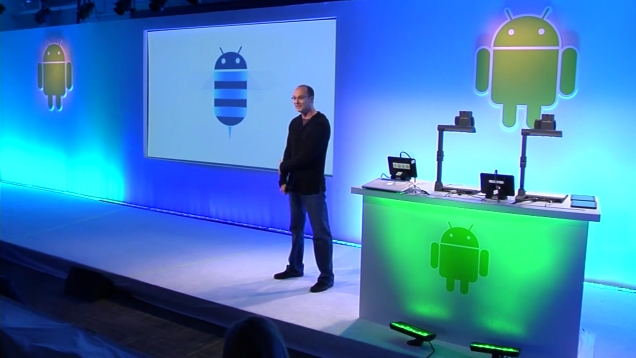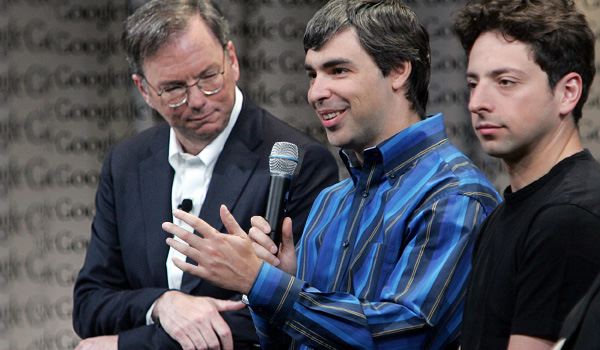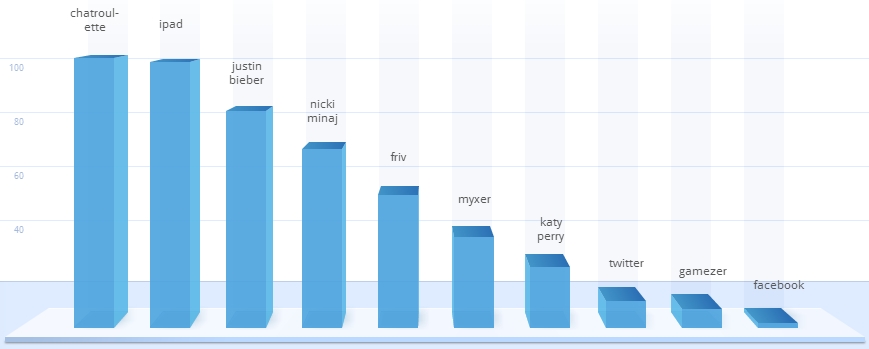Everybody loves the Google’s little green mascot named Android. Heck, he’s the face of their smartphone-turned-tablet user experience. He deserves some of your affection, and now you can properly show it. With the Androidify app from Google you can customize Android to make him look like you–you can alter his size and facial attributes, play dress up, and even throw on some accessories like shoes and glasses for good measure. So wait are you waiting for? Android users, have at it!
Tag Archives: Google
Google sheds light on Honeycomb, intros Android Market Web Store and teases in-app purchases

This week Google held a brief Android-themed event where they highlighted elements of the tablet-specific Honeycomb UI, introduced the Android Market Web Store, and previewed Android Market in-app purchasing. Hop after the break for all the details. Continue reading Google sheds light on Honeycomb, intros Android Market Web Store and teases in-app purchases
Google Art Project brings galleries from around the world to your computer screen

Today Google dipped its paws into the art industry. Art Project is “a unique collaboration with some of the world’s most acclaimed art museums to enable people to discover and view more than a thousand artworks online in extraordinary detail.” In short, over the past 18 months Google’s traveled to 17 art museums around the world and captured super high resolution images of famous artworks. Now online users can take 360 degree tours of individual galleries using the same Street View click, zoom, and pan techniques most are used to using when navigating Google Maps. Google hit up many world renowned museums including The Metropolitan Museum of Art, MoMA, State Tretyakov Gallery, and Van Gogh Museum. And check this: each of the 17 museums hand-picked one piece of artwork to be photographed using gigapixel technology; these super super high definition selections contain around 7 billion pixels allowing users to explore them in extreme detail. For example, the people hidden behind the tree in Ivanov’s ‘The Apparition of Christ to the People’ suddenly become visible thanks to the gigapixel capture. In addition to browsing the beautiful works of art, Google is enabling users to create their own collections, share them with others, and make them sociable with commenting support.
Head over to http://www.googleartproject.com/ to check it out! Look after the break for official PR and some videos detailing the project.
Food for thought: Libraries are dead because of the digitization of books; with instant access to high definition galleries are museums on their way out now as well?
[Via GoogleBlog] Continue reading Google Art Project brings galleries from around the world to your computer screen
Eric Schmidt leaves Google CEO post, Larry Page steps in

On Thursday Eric Schmidt announced that he will be leaving his post as Google CEO come April 4 and Google co-founder Larry Page will fill the role. From that day on, Page will “lead product development and technology strategy” and “take charge of [Google] day-to-day operations,” while Schmidt will stay with the company as Executive Chairman. In a blog post Schmidt says, “I will focus wherever I can add the greatest value: externally, on the deals, partnerships, customers and broader business relationships, government outreach and technology thought leadership that are increasingly important given Google’s global reach; and internally as an advisor to Larry and Sergey.” He hands the reigns to Page under amicable conditions. “In this new role I know [Page] will merge Google’s technology and business vision brilliantly,” he said. “I am enormously proud of my last decade as CEO, and I am certain that the next 10 years under Larry will be even better! Larry, in my clear opinion, is ready to lead.” And what of the other co-founder, Sergey Brin? He “has decided to devote his time and energy to strategic projects, in particular working on new products.” Schmidt adds, “He’s an innovator and entrepreneur to the core, and this role suits him perfectly.” And he concludes, “Larry, Sergey and I have worked exceptionally closely together for over a decade—and we anticipate working together for a long time to come.”
This is certainly a big shakeup for one of the world’s most dominant companies. Whether or not this transitional shift of control affects Google’s products and services…time will tell.
[Via GoogleBlog]
Motorola Xoom & T-Mobile G-Slate will run Android Honeycomb

Motorola and T-Mobile were downright giddy to announce their upcoming tablet devices at CES 2011. That’s because they are excited to bring Honeycomb, Google’s latest iteration of Android built entirely for tablets, to salivating consumers. Since I already detailed Honeycomb, I think it’d be best to simply jump into specs talk. Let’s start with the Motorola Xoom since there’s far more information about this product out there. The Xoom features a 10.1 inch (1280×800) screen and packs NVIDIA’s latest Tegra 2 1GHz dual-core processor and 1GB of DDR2 RAM. There’s a 5 megapixel rear-facing camera with dual LED flash and a 2 megapixel front-facing camera; support for 720p video recording and 1080p video playback; 32GB of onboard storage that’s expandable with SD card support; 802.11n WiFi, Bluetooth; and ports include HDMI out, micro USB 2.0, and a 3.5mm headphone jack. There’s also a built-in gyroscope, barometer, e-compass, accelerometer and adaptive lighting. It will ship with 3G support and eventually gain 4G LTE support on Verizon’s network. As far as battery life is concerned, Moto’s only saying that it supports up to 10 hours of video playback. Note that the Xoom does not pack physical buttons. With Honeycomb, Google no longer requires hardware manufacturers to include buttons along the rim of their devices. What used to be buttons are now illuminated icons that can be made visible on the device in landscape or portrait modes. Motorola says they’ll ship the sexy Xoom tablet as a 3G/Wi-Fi-enabled device in Q1 2011 (we’re in that quarter now, so soon!) and they promise these devices will be upgradeable 4G LTE in Q2. Also in Q2 Moto will introduce an all-out 4G LTE/Wi-Fi- enabled Xoom. According to recent reports, a strictly WiFi-enabled version will also debut in the Spring. The Xoom looks like it’s going to be a hot item when it ships; a speedy Tegra 2 processor and the tablet-optimized Honeycomb OS marriage will surely make for an enjoyable mobile experience.
An honorable mention goes to the T-Mobile G-Slate because it is just one of the few tablets announced at CES 2011 that promises to run Honeycomb when it releases. T-Mobile has partnered with LG to make the hardware. Aside for it being the “first 4G Android 3.0 powered tablet” from T-Mobile, we know nothing else about it really. At the press event T-Mobile and LG execs held up the mystery tablet, and it look like standard fare–a black slate. We’ll have to wait for a more detailed announcement in the coming weeks.
Look in the gallery below for close-ups of the Motorola Xoom, and hop after the break to read some PR and watch a couple introductory product videos.
Continue reading Motorola Xoom & T-Mobile G-Slate will run Android Honeycomb
Android 3.0 (aka Honeycomb) revealed at long last
This week at CES 2011 tablets were all the rage. Sure, we’ve already seen the Samsung Galaxy Tab running Android 2.2 (aka Froyo) and that’s cool. But it simply doesn’t compare to what Google has in store for us next. Android 3.0, internally referred to as Honeycomb, is “built entirely for tablet.” It was designed from the ground up for devices with larger screen sizes, unlike Froyo which is a smartphone OS that gets ported to tablet form factors. Surprisingly Google did not formally unveil the next generation of Android at CES; instead they insisted that other companies (such as Motorola and T-Mobile) highlight the upcoming mobile OS next to their new tablet devices. Since Google has yet to detail Honeycomb in their own words, we can only glean new information about it by watching and dissecting what we see in the “first look” videos uploaded to YouTube by T-Mobile. Embedded above is a video that focuses on the OS as a whole; after the break you’ll find videos that hone in on features including Google Books, the browser, GTalk, Gmail, YouTube, and Maps.
Let’s break it down a bit here. The Honeycomb homescreen (and overall aesthetic) definitely takes design cues from the Tron universe, what with its blue hues and swift animations. Google Search and Voice Search are located at the top left, an app drawer and widget adder are at the top right, favorite applications are lined up at the bottom, bottom left there’s back, home, and app switch icons, and bottom right shows you the time, WiFi signal strength, and battery life. The bulk of the screen houses widgets (Gmail, Calendar, Browser bookmarks, etc.). Featured apps: (1) Books: Your collection of books can be browsed in carousel fashion or bunched together on a homescreen. Reading a book is as easy as tapping the cover and flipping through the pages. Landscape mode makes you read in the two-page format. (2) Browser: It functions like the Chrome browser, really. Tabbed browsing is present, as is incognito mode, bookmarking, and a large on-screen keyboard. (3) GTalk: Obviously Honeycomb will support devices that pack front and back-facing cameras. GTalk integration will allow you to browse through your contact list and initiate video chat sessions. (4) Gmail: The dedicated Gmail app uses the two-column format to display your inbox and other folders on the left pane and your list of expandable messages on the right. (5) YouTube: The newly designed YouTube app features a slick 3D interface and videos are searchable in a carousel-like mode. (6) Maps: Honeycomb packs the latest version of Maps (v 5.0) that is currently available on Android smartphones today; 3D modeling of streets and buildings are present.
And that about does it for now. Until Google decides to announce Honeycomb in a more formal manner, all we can do is feast our eyes on the delectable UI enhancements featured in the uploaded videos from T-Mobile’s camp. Again, they are all posted after the break for your viewing pleasure. Continue reading Android 3.0 (aka Honeycomb) revealed at long last
Want to learn more about this year’s holiday-themed Google doodle?

On Thursday the holiday-themed Google doodle you see right now was unveiled to the masses. This year was rife with all kinds of Google doodles (from Pac-Man to UFOs), but this one’s being touted as the “most ambitious one yet.” Chief Google doodler Michael Lopez (yes, that is a real position) headed this year’s festive doodle with a team of four other artists. It took them over 250 hours to complete the 17 interactive portraits of holiday scenes. Originally, the plan was to unveil the doodle in stages over three days, but at the last minute Google execs decided that it’d be best to push out the doodle in one piece and keep it up for two-and-a-half days. Lopez and his team rushed to make it happen, and they managed to put it up just in time around 9am Thursday morning. The majority of the holiday scenes focus on food, dance, architecture, and textile from all around the world. Google estimates that it has created over 900 doodles since 1998, with approximately 270 of them running in 2010. Of all the doodles thus far, this one seems to be the one that most diverges from spelling out the search engine’s name. Can you find where it says “Google” there? It’s very subtle. Anyway, can’t wait to see what Lopez has in store for us next year!
[Via WSJ]
Google Demo Slam contest gives ordinary people the chance to creatively shine
The G-Men started to think how can we make tech demos fun so people would actually watch and learn from them? Demo Slam is their answer. Google is relying on everyday people (ahem, you don’t need to be a fancy developer) to submit personalized demos that feature Google tech. Using Android phones or Google on the computer, people can show off their creative side by coming up with ways to demonstrate Google tech like search by voice, updates in real-time, and universal search. I’ve included my top five favorite Demo Slam videos in this post. The one embedded above is called “Extra Spicy” and it features two girls using Google Translate to call a real Indian restaurant and order in Hindi. Never thought of giving that a try, now did you?
Look after the break for the others; a group of friends recreates Mt. Rushmore and uses Google Googles to identify the them as the real deal, three brothers see how many marshmallows they can shove into their mouths until Google Search by voice cannot recognize the query “chubby bunny”, Maria Sharapova uses Google Search to answer questions in English and Russian, and then there’s the epic Google Docs animation.
Want to see more tech demos? They are so much fun to watch right? Head over to the official Demo Slam website where you can view all the submissions and vote for your favorites. The contest is still happening, so unleash your creative side and show the world what you’ve got!
[Via GoogleBlog] Continue reading Google Demo Slam contest gives ordinary people the chance to creatively shine
Motorola teases Android tablet, bills it as the next big thing in ‘Tablet Evolution’ video
Check out this slick animated teaser from Motorola. In it the tech company takes us on a journey through the evolution of tablets, from ancient Egyptian hieroglyphic tablets to the modern ones like the iPad. Speaking of the iPad, Motorola made it their mission to slam the Apple tablet in the video: “It’s like a giant iPhone… but it’s like a giant iPhone.” Burn! And if you’re of the speculating kind, let’s dig deeper into the teaser. Though Moto does not unveil the final product, their shiny new red Motorola logo attracts a buzzing bee at the end of the clip. A bee, hm? That matches up quite nicely with the name of Android’s next mobile OS: Honeycomb. Google’s Andy Rubin recently previewed a Motorola tablet running a new version of Android and he boasted that Honeycomb will include features made from the ground up specifically for the touchy tablet form factor. One more thing: Verizon teased via Twitter that they plan on showing off a whole bunch of LTE Android-based devices at CES in January; and this lines up perfectly with the CES 2011 tease at the end of this clip. Will we see a Motorola tablet running Android’s next-gen Honeycomb OS with Verizon LTE support next month? Only time will tell, but I’d put money on it.
Google extends free voice calling in Gmail through the new year

I know you’ve been taking advantage of Google’s free calling in Gmail feature since it was integrated into the mail client back in August. Well in the “spirit of holiday giving” Google has decided to extend free calling for all of 2011. Thanks, Google! Remember, free calls are only applied to those made in the U.S. and Canada.
[Via GmailBlog]
How the world searched, tweeted, and YouTube’d in 2010

Ah 2010, what a year it has been. What’s the best way to find out what was on everyone’s minds over the course of the past year? By looking at the top Google searches, top Twitter trends, and most watched YouTube videos, duh! The search giant has gone all out this year with their public Google Zeitgeist 2010. What were this year’s hottest search terms? Well, just look in the bar graph above! The creepy video chat service Chatroulette took the top prize as the fastest rising query, and the rest of the list includes celebrities Justin Bieber, Nicki Minaj, Katy Perry, Apple’s iPad, game portals Friv and GameZer, ringtone maker Myxer, and social networking sites Facebook and Twitter. Click here to browse the entire Google Zeitgeist report. Search terms are categorized subject matter and region, and Google also put together some snazzy interactive maps to support the data analytics.
Look after the break to learn about the most popular Twitter trends and the most watched YouTube videos of 2010. Continue reading How the world searched, tweeted, and YouTube’d in 2010
Watch the Google Chrome notebook get destroyed in more ways than one
In this unorthodox demonstration video Chrome UX designer Glen Murphy destroys a Cr-48 Chrome OS notebook. Since Chrome OS relies on the cloud to store data, it doesn’t matter what happens to your computer. Get it?



